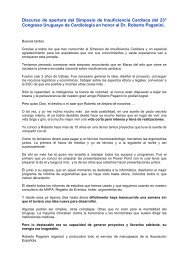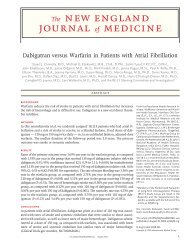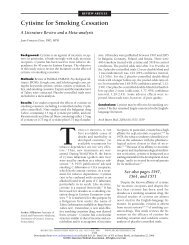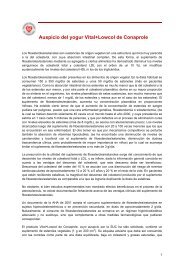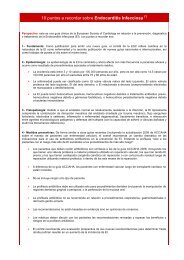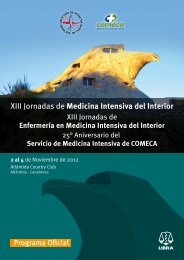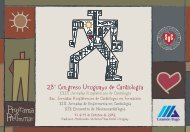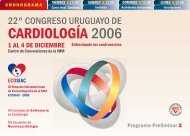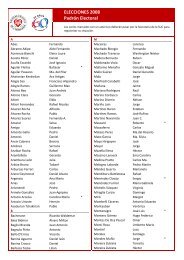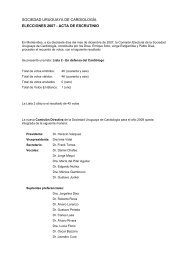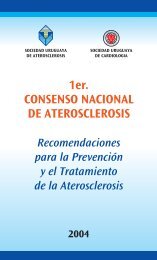XXI Congreso Uruguayo de CardiologÃa Temas libres - Sociedad ...
XXI Congreso Uruguayo de CardiologÃa Temas libres - Sociedad ...
XXI Congreso Uruguayo de CardiologÃa Temas libres - Sociedad ...
You also want an ePaper? Increase the reach of your titles
YUMPU automatically turns print PDFs into web optimized ePapers that Google loves.
REVISTA URUGUAYA DE CARDIOLOGÍA<br />
VOLUMEN 20 | Nº 3 | NOVIEMBRE 2005<br />
54 SEGUIMIENTO A LARGO PLAZO DE UNA COHORTE DE PACIENTES CON INFARTO AGUDO DE MIOCARDIO<br />
TRATADOS CON ANGIOPLASTIA PRIMARIA<br />
DRES. C ARTUCIO, D KORYTNICKI, D MALLO, J POUSO, E BESADA, N LLUBERAS, R LLUBERAS<br />
Instituto <strong>de</strong> Cardiología Intervencionista, Casa <strong>de</strong> Galicia. Montevi<strong>de</strong>o<br />
Objetivo: <strong>de</strong>terminar la tasa <strong>de</strong> eventos a largo plazo <strong>de</strong>spués <strong>de</strong>l alta hospitalaria en una<br />
cohorte <strong>de</strong> 458 pacientes revascularizados con angioplastia primaria (AP) entre el 1 <strong>de</strong> enero <strong>de</strong><br />
1999 y el 31 <strong>de</strong> octubre <strong>de</strong> 2002.<br />
Método: se realizó AP a 493 pacientes (49 Killip IV), con mortalidad hospitalaria <strong>de</strong> 7,1%, con<br />
una ventana síntomas – AP <strong>de</strong> 4,1 ± 3,7 horas. De los 458 pacientes vivos al alta hospitalaria, se<br />
realizó seguimiento en 426 pacientes, edad 61,4±12,9 años, 73,7% (314) hombres, 18,5% (79)<br />
diabéticos, 47,2% (201) con infarto anterior, 72,8% (310) Killip I, Respecto al vaso culpable (vc)<br />
se obtuvo flujo TIMI 3 en 90,6% (386), se implantó stent en 86,9% (370). Mediana <strong>de</strong> seguimiento:<br />
32 meses (P95: 55 meses). Se utilizó método <strong>de</strong> Kaplan-Meier y el log-rank test para curvas<br />
<strong>de</strong> sobrevida, diseñándose un mo<strong>de</strong>lo <strong>de</strong> regresión <strong>de</strong> Cox (estratificada según la ventana <strong>de</strong><br />
tiempo 2,2–6y 6 horas). Se consi<strong>de</strong>raron eventos: muerte, infarto <strong>de</strong> miocardio no fatal<br />
(IM) y revascularización <strong>de</strong> vc.<br />
Resultado: a 5 años <strong>de</strong> seguimiento la tasa <strong>de</strong> sobrevida global fue 84,5%, en los pacientes<br />
Killip I, 88%, en los pacientes con ventana 2 horas 90,5%; siendo la sobrevida significativamente<br />
mayor en p menores <strong>de</strong> 70 años (p=0,0001), no diabéticos (p=0,002) y TIMI 3 en vc<br />
(p=0,001). Presentaron IM 3,3% (14). La necesidad <strong>de</strong> revascularización <strong>de</strong>l vc fue: cirugía<br />
4,2% (18), angioplastia coronaria 3,1% (13). Sobrevida libre <strong>de</strong> eventos 74,4% (317).Fueron<br />
predictores in<strong>de</strong>pendientes <strong>de</strong> muerte la edad (OR 3,30, IC95% 1,81-6,05, p=0,0001), diabetes<br />
(OR 2,05, IC95% 1,09-3,89, p=0,03), flujo TIMI < 3 (OR 2,98, IC95% 1,18-7,52, p=0,02),<br />
clase Killip III-IV(OR 3,13, IC95% 1,35-7,25, p=0,008) y lesión tipo C (OR 2,47, IC95% 1,25-<br />
4,88, p=0,009).<br />
Conclusión: tres cuartas partes <strong>de</strong> la población permaneció sin eventos a largo plazo. La mortalidad<br />
se asoció significativamente a no obtención <strong>de</strong> flujo óptimo, edad mayor <strong>de</strong> 70 años, presencia<br />
<strong>de</strong> diabetes, falla cardíaca severa y lesión compleja.<br />
55 SOBREVIDA ALEJADA DE PACIENTES DIABÉTICOS Y NO DIABÉTICOS TRATADOS CON ANGIOPLASTIA<br />
PRIMARIA, SEGÚN DIÁMETRO DEL VASO CULPABLE<br />
DRES. D KORYTNICKI, C ARTUCIO, D MALLO, J POUSO, E BESADA,<br />
N LLUBERAS, M POUSO, R LLUBERAS<br />
Instituto <strong>de</strong> Cardiología Intervencionista, Casa <strong>de</strong> Galicia. Montevi<strong>de</strong>o<br />
TRABAJO DESTACADO<br />
Hipótesis: controlando los factores predictores, los pacientes diabéticos (pd) con vaso culpable<br />
(vc) no pequeños tratados con angioplastia primaria (AP) tendrán una sobrevida alejada comparable<br />
a la <strong>de</strong> pacientes no diabéticos (pnd).<br />
Objetivo: comparar la sobrevida alejada en una cohorte, <strong>de</strong> pd estratificados por el diámetro<br />
<strong>de</strong>l vc apareados con pnd por factores predictores ya i<strong>de</strong>ntificados.<br />
Método: el diámetro <strong>de</strong>l vc se estimó por el <strong>de</strong>l balón. Vaso pequeño: 2,5 mm. Una regresión<br />
en la cohorte completa <strong>de</strong> AP (n = 426, 1 <strong>de</strong> enero <strong>de</strong> 1999 a 31 <strong>de</strong> octubre <strong>de</strong> 2002)<br />
i<strong>de</strong>ntificó factores predictores in<strong>de</strong>pendientes <strong>de</strong> mortalidad alejada: edad > 75 años, KK<br />
III-IV, flujo TIMI





